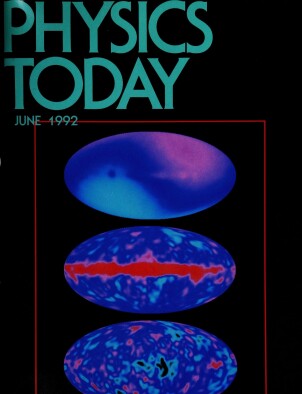Physics with Radioactive Nuclear Beams
DOI: 10.1063/1.881311
The purpose of nuclear physics is to measure properties of specific nuclides and infer from them global properties common to all nuclides. One goal, for example, is to understand nuclear sizes and matter distributions in terms of basic nuclear forces. Another is to understand the variation throughout the periodic table of the dominant quantum states, which are known as the “nuclear shell model” states and are characterized, much as are atomic states, by a principal quantum number and by orbital and total angular momentum quantum numbers. In turn other nuclear phenomena, such as the collective excitations known as giant resonances, can be understood in terms of the shell‐model configurations and basic nuclear parameters.
This article is only available in PDF format
References
1. H. L. Ravn, Phys. Rep. 54, 201 (1979).https://doi.org/PRPLCM
2. R. N. Boyd, C. Rolfs, eds., “Proc. Burr Oak Workshop on Radioactive Beams and Small Cross Sections,” Ohio State U., Columbus, Ohio (1981).
3. R. F. Casten, J. M. D’Auria, C. N. Davids, J. D. Garrett, J. M. Nitschke, B. M. Sherrill, D. J. Vieira, M. Wiescher, E. F. Zganjar, “The Isospin Laboratory: Research Opportunities with Radioactive Nuclear Beams,” LALP 91‐51, Los Alamos Natl. Lab., Los Alamos, N. M. (1991).
4. I. Tanihata, in Treatise on Heavy‐Ion Science, vol. 8, D. A. Bromley, ed., Plenum, New York (1989), p. 443.
5. W. D. Myers, J. M. Nitschke, E. B. Norman, eds., Proc. First Int. Conf. on Radioactive Nuclear Beams, World Scientific, Teaneck, N.J. (1990).
T. Delbar, ed., Proc. Second Int. Conf. on Radioactive Nuclear Beams, Adam Hilger, Bristol, UK (1991).6. I. Tanihata, H. Hamagaki, O. Hashimoto, S. Nagamiya, Y. Shida, N. Yoshikawa, 0. Yamakawa, K. Sugimoto, T. Kobayashi, D. E. Greiner, N. Takahashi, Y. Nojiri, Phys. Lett. B 160, 380 (1985). https://doi.org/PYLBAJ
I. Tanihata, Nucl. Phys. A 522, 275c (1991), and reference therein.7. G. F. Bertsch, B. A. Brown, H. Sagawa, Phys. Rev. C 39, 1154 (1989).https://doi.org/PRVCAN
8. M. Fukuda, T. Ichihara, N. Inabe, T. Kubo, H. Kumagai, T. Nakagawa, Y. Yano, I. Tanihata, M. Adachi, K. Asahi, M. Kouguchi, M. Ishihara, H. Sagawa, S. Shimoura, Phys. Lett. B 268, 339 (1991).https://doi.org/PYLBAJ
9. Y. Suzuki, Y. Tosaka, Nucl. Phys. A 517, 599 (1990). https://doi.org/NUPABL
G. F. Bertsch, J. Foxwell, Phys. Rev. C 41, 1300 (1990). https://doi.org/PRVCAN
G. F. Bertsch, H. Esbensen, Ann. Phys. 209, 327 (1991).https://doi.org/ANPYA210. T. Kobayashi, in Structure and Reactions of Unstable Nuclei, World Scientific, River Edge, N.J. (1992).
11. A. B. Migdal, Sov. J. Nucl. Phys. 16, 238 (1973).https://doi.org/SJNCAS
12. V. Efimov, Comments Nucl. Part. Phys. 19, 271 (1990).https://doi.org/CNPPAV
13. N. Takigawa, H. Sagawa, Phys. Lett. B 265, 23 (1991).https://doi.org/PYLBAJ
14. G. J. Mathews, B. S. Meyer, C. R. Alcock, G. M. Fuller, Astrophys. J. 358, 36 (1990). https://doi.org/ASJOAB
T. Kajino, R. N. Boyd, Astrophys. J. 359, 267 (1990).https://doi.org/ASJOAB15. R. N. Boyd, I. Tanihata, N. Inabe, T. Kubo, T. Nakagawa, T. Suzuki, M. Yonokura, X. X. Bai, K. Kimura, S. Kubono, S. Shimoura, H. S. Xu, D. Hirata, Phys. Rev. Lett. 68, 1283 (1992).https://doi.org/PRLTAO
16. T. Paradellis, S. Kossionides, G. Doukellis, X. Aslanoglou, P. Assimakopoulos, A. Pakou, C. Rolfs, K. Langenke, Z. Phys. A 337, 211 (1990).https://doi.org/ZAANEE
17. M. M. Farrell, R. N. Boyd, X. Gu, J. D. Kalen, J. J. Kolata, R. Lamkin, R. Smith, R. Tighe, K. Ashktorab, F. D. Becchetti, J. Brown, D. Roberts, T.‐F. Wang, in Proc. Second Int. Conf. On Radioactive Nuclear Beams, T. Delbar, ed., Adam Hilger, Bristol, UK (1991), p. 287.
18. S. G. Ryan, M. S. Bessell, R. S. Sutherland, J. E. Norris, Astrophys. J. 348, L57 (1990). https://doi.org/ASJOAB
G. Gilmore, B. Edvardsson, P. E. Nissen, Astrophys. J. 378, 17 (1991).https://doi.org/ASJOAB19. R. K. Wallace, S. E. Woosley, Astrophys. J. Suppl. Series 45, 389 (1981).
M. Wiescher, j. Gorres, F.‐K. Thielemann, H. Ritter, Astron. Astrophys. 160, 56 (1986).https://doi.org/AAEJAF20. P. Decrock, T. Delbar, P. Duhamel, W. Galster, M. Huyse, P. Leleux, I. Licot, E. Lienard, P. Liponik, M. Loiselet, C. Michotte, G. Ryckewaert, P. VanDupper, J. Vanhorenbeeck, J. Vervier, Phys. Rev. Lett. 67, 808 (1991).https://doi.org/PRLTAO
21. T. Motobayashi, T. Takei, S. Kox, C. Perrin, F. Merchez, D. Rebreyend, K. Ieki, H. Murakami, Y. Ando, N. Iwasa, M. Kurokawa, S. Shirato, J. Ruan, T. Ichihara, T. Kubo, N. Inabe, A. Goto, S. Kubono, S. Shimoura, M. Ishihara, Phys. Lett. B 264, 259 (1991). https://doi.org/PYLBAJ
J. Kiener, A. Lefebvre, P. Aguer, C. O. Bacri, R. Bimbot, G. Bogaert, B. Borderie, F. Clapier, A. Coc, D. Disdier, S. Fortier, C. Grunberg, L. Kraus, I. Linck, G. Pasquier, M. F. Rivet, F. St. Laurent, C. Stephan, L. Tassan‐Got, J. P. Thibaud, in Proc. Second Int. Conf. on Radioactive Nuclear Beams, T. Delbar, ed., Adam Hilger, Bristol, UK (1991), p. 311.22. R. Shuam, G. Baur, P. Banerjee, Phys. Rev. C 44, 915 (1991).https://doi.org/PRVCAN
23. M. F. Mohar, D. Bazin, W. Benenson, D. J. Morrissey, N. A. Orr, B. M. Sherrill, D. Swan, J. W. Winger, Phys. Rev. Lett. 66, 1571 (1991).
24. J. J. Cowan, F.‐K. Thielemann, J. W. Truran, Phys. Rep. 208, 268 (1991).https://doi.org/PRPLCM
25. D. Guillemaud‐Mueller, C. Detraz, M. Langevin, F. Naulin, M. deSaint‐Simon, C. Thibault, F. Touchard, M. Epherre, Nucl. Phys. A 436, 37 (1984). https://doi.org/NUPABL
J. A. Winger, J. C. Hill, F. K. Wohn, R. Moreh, R. L. Gill, R. F. Casten, D. D. Warner, Phys. Rev. C 36, 758 (1987).https://doi.org/PRVCAN
More about the Authors
Richard N. Boyd. Ohio State University.
Isao Tanihata. RIKEN, Institute of Physical and Chemical Research, Japan.




